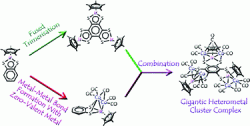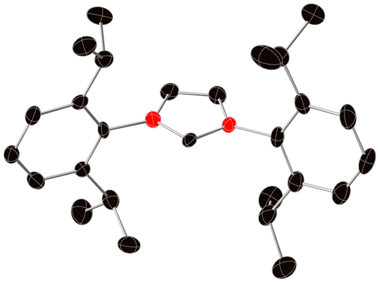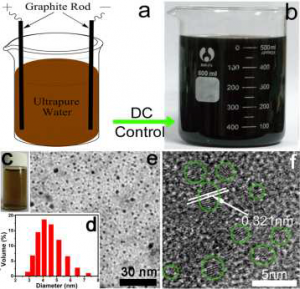This month sees the following articles in Dalton Transactions that are in the top ten most accessed:-
Synthesis and characterization of a tris(2-hydroxyphenyl)methane-based cryptand and its triiron(iii) complex
Gary L. Guillet , Forrest T. Sloane , Matthieu F. Dumont , Khalil A. Abboud and Leslie J. Murray
Dalton Trans., 2012,41, 7866-7869 DOI: 10.1039/C2DT30312D
Recent progress in the synthesis of inorganic nanoparticles
C. N. R. Rao , H. S. S. Ramakrishna Matte , Rakesh Voggu and A. Govindaraj
Dalton Trans., 2012,41, 5089-5120 DOI: 10.1039/C2DT12266A
New catalysts with unsymmetrical N-heterocyclic carbene ligands
Johanna Tornatzky , Axel Kannenberg and Siegfried Blechert
Dalton Trans., 2012,41, 8215-8225 DOI: 10.1039/C2DT30256J
Application of inorganic chemistry for non-cancer therapeutics
Katherine J. Franz
Dalton Trans., 2012,41, 6333-6334 DOI: 10.1039/C2DT90061K
Applications of luminescent inorganic and organometallic transition metal complexes as biomolecular and cellular probes
Kenneth Kam-Wing Lo , Alex Wing-Tat Choi and Wendell Ho-Tin Law
Dalton Trans., 2012,41, 6021-6047 DOI: 10.1039/C2DT11892K
A carboxylate-based dinuclear dysprosium(iii) cluster exhibiting slow magnetic relaxation behaviour
Biplab Joarder , Abhijeet K. Chaudhari , Guillaume Rogez and Sujit K. Ghosh
Dalton Trans., 2012,41, 7695-7699 DOI: 10.1039/C2DT30643C
Selective anion sensing by a ruthenium(ii)–bipyridyl-functionalized tripodal tris(urea) receptor
Yongjing Hao , Peiju Yang , Shaoguang Li , Xiaojuan Huang , Xiao-Juan Yang and Biao Wu
Dalton Trans., 2012,41, 7689-7694 DOI: 10.1039/C2DT12488B
Magnetic and optical bistability in tetrairon(iii) single molecule magnets functionalized with azobenzene groups
Thazhe Kootteri Prasad , Giordano Poneti , Lorenzo Sorace , Maria Jesus Rodriguez-Douton , Anne-Laure Barra , Petr Neugebauer , Luca Costantino , Roberta Sessoli and Andrea Cornia
Dalton Trans., 2012,41, 8368-8378 DOI: 10.1039/C2DT30172E
A tris(2-quinolylmethyl)amine scaffold that promotes hydrogen bonding within the secondary coordination sphere
Cameron M. Moore and Nathaniel K. Szymczak
Dalton Trans., 2012,41, 7886-7889 DOI: 10.1039/C2DT30406F
Targeted therapy vs. DNA-adduct formation-guided design: thoughts about the future of metal-based anticancer drugs
Gianni Sava , Gérard Jaouen , Elizabeth A. Hillard and Alberta Bergamo
Dalton Trans., 2012,41, 8226-8234 DOI: 10.1039/C2DT30075C
Why not take a look at the articles today and blog your thoughts and comments below.
Fancy submitting an article to Dalton Transactions? Then why not submit to us today or alternatively email us your suggestions.
Comments Off on Top ten most accessed articles in May
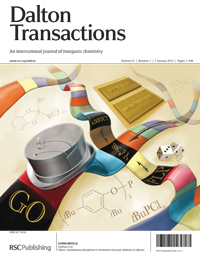 The 2011 Journal Citation Reports ® (Thomson Reuters, 2012) have been released and the Dalton Transactions impact factor* has increased to 3.84!
The 2011 Journal Citation Reports ® (Thomson Reuters, 2012) have been released and the Dalton Transactions impact factor* has increased to 3.84!











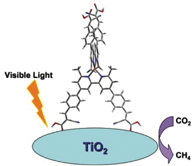 Photochemical reduction of greenhouse gas, carbon dioxide into higher energy content fuels is attractive because it utilises a renewable energy source – the sun. Most catalysts that are already used for this process (TiO2 and metallic clusters based on Cu, Pt and Rh) need ultraviolet light for excitation and have a low conversion efficiency, prohibiting wide scale industrial application.
Photochemical reduction of greenhouse gas, carbon dioxide into higher energy content fuels is attractive because it utilises a renewable energy source – the sun. Most catalysts that are already used for this process (TiO2 and metallic clusters based on Cu, Pt and Rh) need ultraviolet light for excitation and have a low conversion efficiency, prohibiting wide scale industrial application. 
